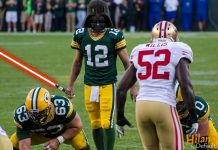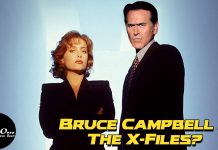The first thing one notices when looking at Mike Nichols‘ Working Girl is its incredible cast. After all, it’s a film that features Indiana Jones (Harrison Ford), Ellen Ripley (Sigourney Weaver), Jack Ryan (times two! Ford and Alec Baldwin), Keyser Soze (spoiler alert: Kevin Spacey), and even Agent Fox Mulder (David Duchovny in his film debut). It’s almost disappointing to discover that it isn’t a forgotten 1980’s action masterpiece – although the title should have been the first clue.
Working Girl is the story of Tess McGill (Melanie Griffith), a low-class secretary with a business degree dreaming of getting her chance to break out as a stockbroker. When her boss (Weaver) tries to steal her ideas and then promptly breaks her leg, Tess seizes the moment to prove herself by attempting to implement her idea, using her boss’ now vacant office.
Working Girl is a Wall Street fairy tale – one that’s as much an embodiment of its time as its poofy hairstyles are. The film opens Disney style, with sweeping shots and Griffith making an unspoken birthday wish whilst blowing out candles. From the start, Mike Nichols sets the stage for a modern fantasy. Griffith is the stockbroking Cinderella, only instead of leaving a shoe behind, it’s a stack of files. In place of adoring animals following her every move, she has stuffed bunnies on her desk. Harrison Ford is the befuddled Prince Charming, originally falling for the illusion and then coming to appreciate the woman beneath the dress suit. Sigourney Weaver is the wicked stepsister (herself commenting that she and Griffith are practically twins at the film’s onset). It’s a preposterous set up, but it’s charming nonetheless, casually engaging the audience to play along and it works.
The late 80’s was a time when Harrison Ford was trying to diversify from his early successes playing Han Solo and Indiana Jones. From his Oscar-nominated role in Peter Weir’s Witness (1985), to the haunted genius in Mosquito Coast (1986), and to the overcome everyman in Roman Polanski’s thriller Frantic (1988), Ford was branching out, working with some of the most esteemed directors in the industry. His comic, romantic lead in Working Girl is effective, even though he isn’t given much to do apart from portraying the obligatory romantic interest (his character doesn’t make an appearance until past the film’s first half-hour). Ford’s presence doesn’t drive the film, however, as it is Melanie Griffith’s story. Her sweet-natured naivete and optimistic drive is appealing and she holds her own even when threatened to be overshadowed by the more colorful performances of Weaver and Joan Cusack as her best friend.
Winning an Academy Award for Carly Simon’s “Let the River Run” plus a further five nominations, including Best Picture, Working Girl is an unexpected delight. It is a pleasant throwback and serves as the perfect antithesis to the more pessimistic business films of the era, such as Wall Street and Glengarry Glenn Ross, while still finding time to highlight the duplicity and showmanship of the industry.































